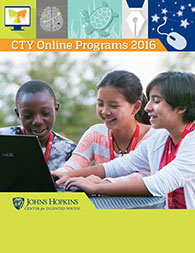Honors Grade 5 Mathematics
Revision as of 18:11, 14 March 2016 by Lukepf04 (talk | contribs) (Created page with "{{CTY Online Courses}} Honors Grade 5 Mathematics is a CTY Online course for students who have met the qualifications of the math SCAT score and have completed grade 5...")
Honors Grade 5 Mathematics is a CTY Online course for students who have met the qualifications of the math SCAT score and have completed grade 5 math. The course lasts about 6 months and its course code is HG5.
Contents
- 1 Course Description
- 2 List of Topics
- 3 Whole Numbers and Patterns
- 4 Introduction to Algebra
- 5 Decimals
- 6 Number Theory and Fractions
- 7 Operations with Fractions
- 8 Data Displays
- 9 Proportional Relationships
- 10 Geometric Relationships
- 11 Measurement
- 12 Area and Volume
- 13 Integers and the Coordinate Plane
- 14 Probability
Course Description
From the CTY Online catalog:
The sequence covers concepts typically found in an honors mathematics curriculum and is aligned with the Common Core Standards. This course, drawing on software provided by Thinkwell, covers a full-year honors curriculum and prepares students for success in Honors Pre-algebra. This course begins with a review of grade 4 concepts. The course is equivalent to a full year of mathematics.
Topics include:
- whole numbers and patterns
- introduction to algebraic variables and expressions
- decimals
- number theory
- fractions
- operations with fractions
- data displays
- proportional relationships
- geometric relationships
- measurement
- area and volume
- integers and the coordinate plane
- probability
List of Topics
Whole Numbers and Patterns
- Comparing and Ordering Whole Numbers
- Estimating with Whole Numbers
- Exponents
- Order of Operations
- Properties and Reasoning Methods
- Choose the Method of Computation
- Patterns and Sequences
Introduction to Algebra
- Variables and Expressions
- Translate Between Words and Math
- Translating between Tables and Expressions
- Equations and their Solutions
- Addition Equations
- Subtraction Equations
- Multiplication Equations
- Division Equations
Decimals
- Representing, Comparing, and Ordering Decimals
- Rounding and Estimating Decimals
- Adding and Subtracting Decimals
- Multiplying Decimals
- Applying Exponents: Scientific Notation
- Dividing Decimals by Whole Numbers
- Dividing by Decimals
- Solving Decimal Equations
Number Theory and Fractions
- Divisibility
- Factors and Prime Factorization
- Greatest Common Factor
- Decimals and Fractions
- Equivalent Fractions
- Mixed Numbers and Improper Fractions
- Comparing and Ordering Fractions
- Adding and Subtracting with Like Denominators
- Estimating Fraction Sums and Differences
Operations with Fractions
- Least common Multiple
- Adding and Subtracting with Unlike Denominators
- Adding and Subtracting Mixed Numbers
- Regrouping to subtract Mixed Numbers
- Solving Fraction Equations: Addition and Subtraction
- Multiplying Fractions by Whole Numbers
- Multiplying Fractions
- Multiplying Mixed Numbers
- Dividing Fractions and Mixed Numbers
- Solving Fraction Equations: Multiplication and Division
Data Displays
- Measures of Central Tendency
- Frequency Tables, Stem-and –Leaf Plots, and Line Plots
- Bar Graphs and Histograms
- Line Graphs
- Misleading Graphs
- Choosing an Appropriate Display
Proportional Relationships
- Ratios and Rates
- Applying Rates and Ratios
- Proportions
- Similar Figures
- Indirect Measurement
- Scale drawings and Maps
- Percents
- Percents, Decimals, Fractions
- Percent Problems
- Using Percents
Geometric Relationships
- Points, Lines, and Planes
- Measuring and Classifying Angles
- Angle Relationships
- Classifying Lines
- Triangles
- Quadrilaterals
- Polygons
- Geometric Patterns
- Congruent Polygons
- Transformations
- Line Symmetry
Measurement
- Understanding Customary Units of Measure
- Understanding Metric Units of Measure
- Converting Customary Units
- Converting Metric Units
- Time and Temperature
- Finding Angle Measures in Polygons
- Perimeter
- Circles and Circumference
Area and Volume
- Area of Rectangles and Parallelograms
- Area of Triangles and Trapezoids
- Area of Composite Figures
- Changing Dimensions
- Area of Circles
- Three-Dimensional Figures
- Volume of Prisms
- Volume of Cylinders
- Surface Area
Integers and the Coordinate Plane
- Integers in Real-World Situations
- Comparing and Ordering Integers
- The Coordinate Plane
- Adding Integers
- Subtracting Integers
- Multiplying Integers
- Dividing Integers
- Solving Integer Equations
Probability
- Introduction to Probability
- Experimental Probability
- Counting Methods and Sample Spaces
- Theoretical Probability
- Compound Events
- Making Predictions
